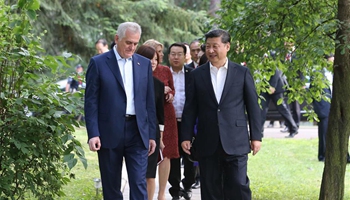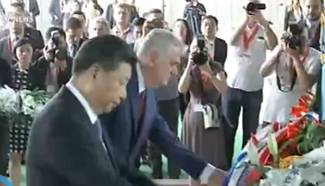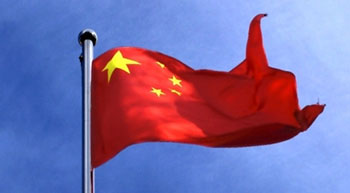BEIJING, June 18 (Xinhua) -- When Zeng Minping and his family arrived in Warsaw, they were surprised to see so many Chinese-made products in their local Ikea store.
A salesclerk told them that the goods were shipped to Poland by rail and Ikea staff in the freight department often drove 140 km away to Kutno railway station in Lodz to fetch the goods.
The Yuxinou (Chongqing-Xinjiang-Europe) Railway stretches from Chongqing in southwest China to Duisburg, close to Germany's border with the Netherlands. Since January 2011, over 600 cargo trains have carried Chinese products to Europe.
Kutno is a key railway hub in Poland and central Europe and in 2014, the first China-bound cargo train departed from there.
Since then, the Yuxinou Railway has attracted cargo from neighboring countries to Kutno, with businesses keen to transport all kinds of products to China in the most efficient possible way.
Passing across the Chinese frontier through the Alataw Pass in Xinjiang, Europe-bound trains cross Kazakhstan, Russia, Belarus, Poland and reach Germany after about 14 days.
In 2015, Zeng with his wife and daughter spent about three months to travel over 11,000 km through the route and reached the terminal in Duisburg.
During the journey they witnessed the rise of China's influence along the route, not just Chinese products but local people who can even speak some simple Chinese phrases and more and more people have heard of the Silk Road Economic Belt.
The Silk Road Economic Belt and the 21st Century Maritime Silk Road, more commonly known as the Belt and Road Initiatives proposed by China, will see Chinese companies expand their presence abroad and greater regional integration and development in terms of infrastructure and trade.
The ancient Silk Road linked China and Europe, and people along the road traded not only commodities but exchanged their cultures and civilizations. Today, China is European Union's second largest trading partner and EU is China's largest trade partner.
Cargo trains were a logical development, opening a new channel for the transfer of goods to and from China's central and western regions to compete with the traditional maritime route from the east coast. A total of 16 cities now have regular cargo trains to Europe.
From Harbin in northeast China, Yiwu in the east, Wuhan and Changsha in central China, cargo trains carry IT equipment, automobiles and other products to Poland, Germany, Czech Republic and Spain, and bring the best of Europe to Chinese customers.
"The volume of our business is increasing by 50 to 60 percent every year," said Liu Lei, general manager of Shanghai Seacoast International Logistics Company, a shipping agent dealing with cargo trains leaving from Zhengzhou in central China's Henan Province.
Liu's company started their cargo train business over two years ago. As the route becomes more regular, freight volume keeps increasing and the cost has fallen by a half.
Rail freight is slower than air and more expensive than shipping, but Liu said its advantages attract specific clients and they are increasing.
The cargo is generally high added-value items and clients have strict demands on delivery requirements or have urgent orders, said Liu, whose clients are mostly German companies with factories in China.
Trains from Zhengzhou arrive in Poland, the gateway to the EU from the east. "Poland is now a major manufacturing base in the European Union with relatively low labor costs," said Liu.
"My business directly originated from Yuxinou route," said Yang Jie, executive president of HeKa International GmbH who has a mall for German products in Chongqing.
Born in Chongqing and now living in Germany, Yang sells Chinese products to Germany. Knowing that cargo trains from China often returned empty, Yang decided to transport German products back to hometown.
In November 2015, the 50,000 square meter "German Life Mall" opened in Chongqing. Yang expects annual sales to reach 5.5 billion yuan (835 million U.S. dollars).
Since the Belt and Road Initiatives began to take shape, over 1,700 trains have passed from China to Europe along 39 lines. Earlier this month, the government and China Railway Corporation (CRC) unified these routes under the China Railway Express brand.
A CRC press release hypothesized that the move would strengthen the overall competitiveness of Chinese railway transportation in the world.
"The rail route has promoted trade and economic exchanges along the Silk Road, and helped and driven the development of China's open economy," said Li Pumin, secretary general of China's National Development and Reform Commission.











